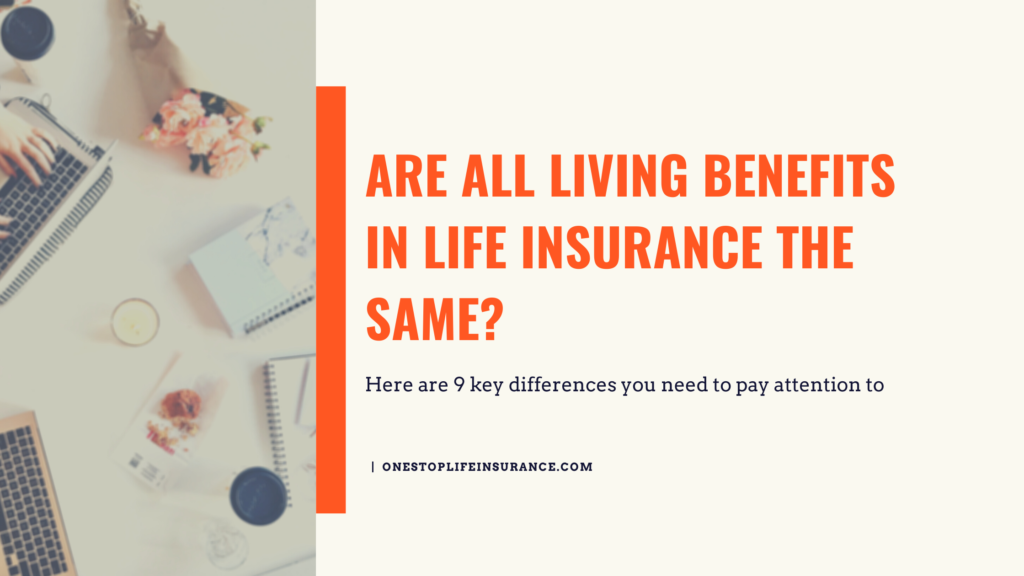Are all companies offering the same living benefits?
Accelerated Benefit Riders or as often referred to as living benefits are gaining momentum. More and more people are learning about the option to have this feature offered by their life insurance carrier. However, what exactly are living benefits and are living benefits the same amongst the life insurance companies?
Well, this is exactly what we would cover. Our objective is to shed some more light on the available options you have when it comes to living benefits. We are strong believers that the more you know, the better decisions you can make for you and your family.
If you have any additional questions or would like us to provide you with a personalized review of your needs, simply reach out to us. You can fill out the instant quote form on the page, send us a message, or simply give us a call.
What we will cover
Types of living benefits and what each category covers
Are all companies offering the same living benefits
How to select the right option for you
A common question we’ve received: who decides how to spend the money

Ok, let’s jump right in…
What are living benefits
We’d like to think of living benefits as a modern take on life insurance. They allow you to “use” your policy while still alive, should you suffer a qualifying medical condition. In other words, you don’t have to die for the policy to payout. The benefits are available in a term, as well as in permanent insurance options. In most instances, they are built into the policy. However, there are companies that would allow them to add them at the time of application for an additional cost.
We’ve created separate guides on:
- Are living benefits really worth it – outlining what exactly are living benefits and should have a policy with Accelerated Benefits Riders
- 21 FAQs about living benefits – we’ve answered some of the most common questions when it comes to living benefits, ranging from how are the funds paid and do you have to pay them back.
- Cons of life insurance with living benefits – while having the option to accelerate your death benefit is valuable, we wanted to advise you that there are several drawbacks that you need to be aware of.
Types of living benefits and what they cover
There are 3 major categories of living benefits. We would list them and give you an example of the qualifying health conditions allowing you to accelerate your death benefit.
Terminal illness
This a very common rider and many insurance carriers offer it at no additional charge. Under this rider, the policy owner is able to file for acceleration should the insured is diagnosed with a terminal condition by certified medical personnel. He is reasonably expected to die within the next 12-24 months.
Chronic illness
The owner would be able to file for acceleration under this rider, should the insured:
“Is unable to perform, without substantial assistance from another person, at least 2 of 6 ADLs for a period of at least 90 days, due to a loss of functional capacity; or • Requires substantial supervision by another person to protect the insured from threats to health and safety due to the Insured’s severe cognitive impairment.”
ADL stands for Activities of Daily Living. There are 6 ADLs: bathing, continence, dressing, eating, toileting, transferring.
This rider is oftentimes compared to long term care insurance. However, it is not. There are several differences between a chronic illness rider in life insurance and long term care. In fact, we’ve created a separate guide outlining the differences.
Critical illness
To qualify for acceleration under this rider, the insured has experienced any of the conditions below:
- Heart Attack
- Stroke
- Invasive Cancer
- Diagnosis of End Stage Renal Failure
- Major Organ Transplant
- Diagnosis of ALS
- Blindness – total and permanent loss of sight in both eyes as a result of disease or endures and results in a reduced life expectancy
- Paralysis – complete and permanent loss of use of 2 or more limbs through neurological injury.
- Arterial Aneurysms
- Central nervous System Tumors
- Major Multi System Trauma
- Arterial Aneurysms
- Central Nervous System Tumors
- Major Multi System Trauma
- Auto Immune Deficiency Syndrome (AIDS)
- Severe Disease of Any Organ
- Severe Central Nervous System Disease
- Major Burns
- Loss of Limbs

Important things to keep in mind:
No accelerated benefit will be paid under ANY rider for a qualifying event that occurs before the date of the issue of the base policy.
No accelerated benefit will be paid under any rider for a condition that results from any self-inflicted injury or attempted suicide.
Are living benefits in life insurance the same amongst all carriers
This is an important question to ask when you are reviewing your options. The answer is no. Even though a company may offer living benefits, there could be a wide difference amongst carriers on various criteria:
Number of qualifying triggers
Under triggers we mean, the qualifying events under which you could accelerate your policy. Some companies offer only 9 triggers/events, while others could go up to 18 different events.
Percentage of death benefit eligible for acceleration
This is another major difference. Some companies would allow you to accelerate up to 90 to 100% of your death benefit for a terminal, chronic, or critical illness, while others would allow you to accelerate up to a certain percentage. For example:
- Chronic illness • max 24% of the Death benefit
- Critical illness• max 95% of the Death benefit
- Terminal illness• max 95% of the Death benefit
Available coverage amount
Some companies have a limit to the amount of insurance you are able to purchase and therefore accelerate.
For example, based on age, and income a company may limit you only up to $150,000 in life insurance. This $150,000 is used to calculate the maximum benefit you can accelerate. Please see below:
Should the insured suffers a chronic illness, he or she might be able to only accelerate or file for 24% of the death benefit or $36,000 ($150K x 24%). Based on his or her condition, the company would make an offer.
Therefore it is important to keep in mind how much life insurance you can secure and what portion of it you are allowed to accelerate. This is extremely important when shopping for life insurance.
Not all companies offer all 3 types of living benefits
We’ve run into clients who were told that their policy does include living benefits. While this is true, it is not 100% accurate. In some instances, these clients are able to accelerate their life insurance policy ONLY if they suffer a terminal condition. Their policy does not offer an accelerating option under chronic or critical illness.
Not all living benefits in life insurance are the same!
Life expectancy
While on the topic of terminal illness, companies’ guidelines vary as well. Some companies would allow acceleration if an illness or chronic condition that is reasonably expected to result in the death of the Rider Insured within 24 months or less. Others would only allow if it is within 12 months or less.
Are living benefits included at no additional cost
Some carriers have living benefits built-in and included at no additional cost, while others have the option to add them for a small premium. Just check in with your agent to ensure living benefits are an option for you.
Would you have a choice on how to receive the funds
Some companies give you a choice between a lump sum or installments, while others would only pay the benefits via installments.
How much is the administrative fee
Companies charge an administrative fee to process a claim under the accelerated benefit riders. Some companies have a fee of $250, while others up to $500. While this is a big difference, we suggest you take into account which company offers stronger living benefits and use that as a deciding factor.
What state you live in also makes a difference
When it comes to insurance, different states have different rules and options. Take the state of California for example. There are not many carriers that offer living benefits in the state of California. In addition, the ones that do may have different restrictions on available policies, age, and type of benefit. For additional information, review our guide on living benefits for California.
How to select the right plan for you
With so many different variables and options, sometimes it could be challenging to select the right plan for you. So, what should you do?
Ask questions
This is extremely important. Take the time and be diligent. Ensure that you know what the plan covers and what is excluded. We understand that discussing life insurance may not be very appealing, but it is important.
Read the policy/or the application
This is another step you can take to protect yourself and your family. Once you are ready to sign your life application, take a second to review it. Most companies would have a separate section outlining the living benefits if they are available.
In addition, review your policy, when the company sends it to you. You need to pay close attention to:
- The names (yours and the beneficiaries)
- The death benefit/premium column
- Review the exclusions
- Learn about the living benefits (Accelerated Benefit Riders) and what conditions would be considered qualifying triggers
- Ensure your answers to any application questions were marked correctly.
How easy is the application process
We want you to be aware that there are A-rated carriers who would offer coverage with living benefits without having the need to complete a medical exam.

We want to point out that living benefits are not cash value. They are completely different. In fact, you can have a policy that has only living benefits, or only cash value. You can also have a policy that offers both, living benefits and cash value.
A common question: What can you use the money for?
This is a common question we receive. The benefit is payable to you, not your doctor, hospital, or health insurance company. You are in charge. You can use it to help with medical bills, rent/mortgage, seek alternative treatment and etc. For additional information, you can review our posts on:
Can your live insurance keep you alive
Can your live insurance keep you out of jail
In Conclusion,
Not all living benefits in life insurance are the same. They differ not only based on qualifying triggers, coverage amount but even based on the state you live in. Our advice is to take the time and carefully review your options to determine if living benefits are right for you. In addition, do not forget to share with your agent that having life insurance with living benefits is important to you. So, he or she can focus on finding you the best value option.
We hope you find this guide helpful. If you have any questions or would like us to evaluate your options, simply reach out to us.
Thank you